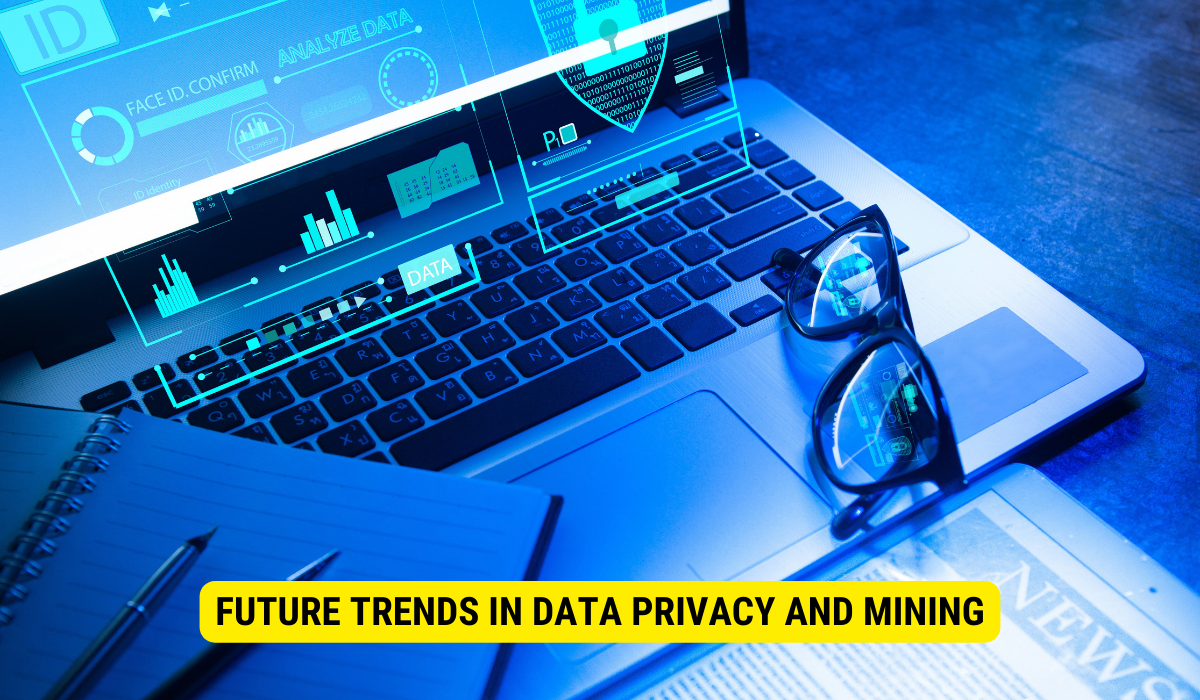To maintain privacy in data mining, adopt techniques like anonymization, differential privacy, and data perturbation. Limit data access, educate users, and comply with privacy regulations.
Data mining is an influential tool that lets organizations extract valuable perceptions from vast amounts of data. However, as data mining continues to grow, so do privacy concerns. This article will explore strategies for maintaining privacy in data mining, the importance of preserving privacy, and the tools and technologies available to protect sensitive information. Let’s dive in!
Understanding the Concept of Data Mining
Data mining involves discovering patterns and extracting useful information from large datasets. It has become integral to various industries, including healthcare, finance, and marketing. By analyzing data, organizations gain insights that help them make informed decisions, optimize operations, and enhance customer experiences.
In today’s digital world, data mining is crucial in leveraging massive amounts of data individuals and organizations generate. From social media posts to online shop habits, every digital interaction leaves a trace of valuable information. However, this treasure trove of data also raises privacy concerns.
The Role of Data Mining in Today’s Digital World
Data mining is the fuel that powers personalized recommendations, targeted advertisements, and predictive analytics. It enables businesses to understand consumer behavior, optimize marketing campaigns, and enhance customer satisfaction. Moreover, data mining is instrumental in areas such as healthcare, where it can assist in diagnosis, treatment, and disease prevention.
However, the very nature of data mining raises questions about the privacy of personal information. With access to vast amounts of data, organizations must take proactive steps to ensure individuals’ privacy rights are respected.
The Intersection of Data Mining and Privacy
The proliferation of data mining techniques has sparked a debate about the potential risks it poses to privacy. Organizations must balance leveraging data for valuable insights and protecting individuals’ sensitive information.
Data mining can potentially compromise privacy in various ways. One concern is the possibility of re-identification, where seemingly anonymized data can be linked back to an individual. Additionally, aggregating disparate data sources can generate detailed profiles, revealing intimate details about individuals’ lives.
Organizations need to understand the ethical and legal implications of data mining and take steps to address these concerns. Safeguarding privacy should be an integral part of any data mining strategy.
The Importance of Privacy in Data Mining
Privacy is a fundamental right that individuals should have control over. Maintaining privacy is essential in data mining for building customer trust, avoiding legal repercussions, and ensuring ethical data practices.
Potential Risks and Threats to Privacy
As organizations collect and analyze vast amounts of personal data, they must be aware of the potential risks and threats to privacy. One risk is unauthorized access to sensitive information through security breaches or insider threats. Another concern is organizations’ potential misuse of data, such as selling or sharing personal information without consent.
Data breaches have become increasingly common, and their consequences can be severe. Customers lose faith in organizations that fail to protect their privacy, leading to reputational damage and potential legal action. Therefore, organizations must adopt robust security measures and strict data protection policies.
Legal and Ethical Implications of Data Mining
Data mining practices must adhere to legal and ethical guidelines to ensure the fair treatment of individuals’ personal data. Laws, for instance, the General Data Protection Regulation in Europe & the (CCPA) California Consumer Privacy Act in the United States, have been implemented to safeguard individuals’ privacy rights.
Organizations should obtain explicit agreement from individuals before collecting their data, ensure data collection and usage transparency, and allow individuals to opt-out. Additionally, data should be anonymized whenever possible to minimize the risk of re-identification.
Adhering to legal requirements protects individuals’ privacy and helps organizations build trust and maintain a positive reputation.
Strategies for Maintaining Privacy in Data Mining
While the challenges of maintaining privacy in data mining are significant, organizations can employ several strategies and techniques to protect sensitive information. Let’s explore some of them:
Privacy-Preserving Data Mining Techniques
Privacy-preserving data mining techniques aim to extract useful information from data while minimizing the risk of privacy breaches. These techniques include anonymization, data minimization, and differential privacy.
Anonymization involves removing or modifying personally identifiable information (PII) from datasets to make it difficult to link specific individuals to their data. Data minimization, on the other hand, focuses on collecting and storing only the essential data required for analysis. The risk of privacy breaches is mitigated by reducing the amount of personal information stored.
Differential privacy is a concept that guarantees a level of privacy protection by injecting controlled noise or perturbation into data. This technique ensures that the privacy of individuals is preserved even when analyzing aggregate data.
Implementing Privacy Policies in Data Mining
Organizations must establish robust privacy policies governing how data is collected, stored, and used. These policies should outline the procedures and safeguards to protect sensitive information.
It is essential to communicate these privacy policies to customers. Providing individuals with information about how their data is being used and giving them control over their privacy settings enhances transparency and builds trust.
Tools and Technologies for Privacy in Data Mining
Various tools and technologies have emerged to address privacy concerns in data mining. These technologies enable organizations to protect sensitive information while still benefiting from data analysis:
Overview of Privacy-Enhancing Technologies
Privacy-enhancing technologies, or PETs, protect individuals’ privacy during data collection, storage, and analysis. PETs encompass a range of solutions, including anonymization tools, secure multiparty computation, and federated learning.
As mentioned earlier, anonymization tools help remove or modify personally identifiable information from datasets. Safe multiparty computation allows numerous parties to jointly analyze data without sharing the underlying data. Federated learning facilitates collaborative model training across multiple devices without sharing raw data.
The Role of Encryption in Data Privacy
Encryption plays a critical role in protecting data privacy. By encoding data at rest and in transit, organizations can ensure that it remains illegible and unusable even if it falls into the wrong hands.
End-to-end encryption, where data is encrypted from the sender to the recipient, is commonly employed to secure sensitive information. Additionally, secure key management practices are crucial to maintaining the effectiveness of encryption.
Future Trends in Data Privacy and Mining

Data privacy and mining are continually evolving to address emerging challenges and opportunities. Let’s take a look at some future trends:
Impact of Emerging Technologies on Data Privacy
The rise of developing technologies, for instance, artificial intelligence (AI), machine learning (ML), and the (IoT) Internet of Things, brings both benefits and new privacy concerns. AI and ML algorithms have the potential to uncover insights and patterns that were previously undetectable, but they also raise questions about algorithmic bias and personal data protection.
Integrating IoT devices into various aspects of our lives generates vast amounts of data, increasing the need for robust privacy measures. As organizations continue to leverage these technologies, it is crucial to prioritize privacy by design and consider the ethical implications of data mining.
The Future of Privacy in the Era of Big Data
The era of big data presents both opportunities and challenges for privacy. As the volume, velocity, and variety of data grow, organizations must develop sophisticated techniques to protect privacy while gaining valuable insights. Advances in privacy-preserving techniques and technologies will be pivotal in striking this balance.
Key Takeaways
- Data mining involves extracting valuable information from large datasets.
- Privacy is essential in data mining to maintain trust and adhere to legal and ethical guidelines.
- Privacy-preserved data mining techniques and privacy-enhancing technologies help mitigate privacy risks.
- Encryption and robust privacy policies are essential tools for protecting privacy.
- The future of data mining and privacy involves integrating emerging technologies and addressing big data challenges.
FAQs
Why is privacy important in data mining?
Privacy is important in data mining because it ensures individuals control their personal information and helps build trust between organizations and customers. Moreover, privacy protection is required by law in many jurisdictions to safeguard individuals’ rights.
What are the potential risks to privacy in data mining?
Potential risks to privacy in data mining include unauthorized access to sensitive information, data breaches, and the potential for organizations to misuse data without consent. Additionally, aggregating data from various sources can lead to the creation of detailed profiles, compromising individuals’ privacy.
How can organizations maintain privacy in data mining?
Organizations can maintain privacy in data mining by implementing privacy-preserving techniques such as anonymization, data minimization, and differential privacy. They should also establish robust privacy policies, obtain informed consent from individuals, and employ encryption methods to protect data at rest and in transit.
What are privacy-enhancing technologies (PETs)?
Privacy-enhancing technologies are solutions designed to protect individuals’ privacy during data collection, storage, and analysis. These technologies include anonymization tools, secure multiparty computation, and federated learning.
What is the future of privacy in data mining?
The future of privacy in data mining involves addressing the challenges and opportunities posed by emerging technologies such as AI, ML, and IoT. Privacy by design, ethical considerations, and the development of advanced privacy-preserving techniques will be key to protecting privacy in the era of big data.
Conclusion
In conclusion, privacy in data mining is a complex and ever-evolving topic. Organizations must proactively adopt privacy-preserving techniques, implement robust privacy policies, and leverage tools and technologies to protect individuals’ sensitive information. By prioritizing privacy, organizations can maintain customer trust, comply with legal requirements, and uphold ethical data practices in an increasingly data-driven world.

